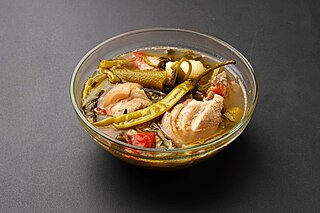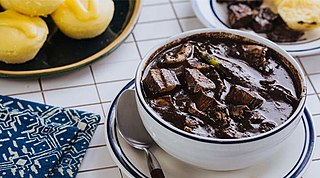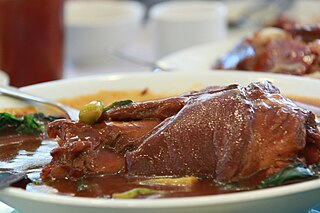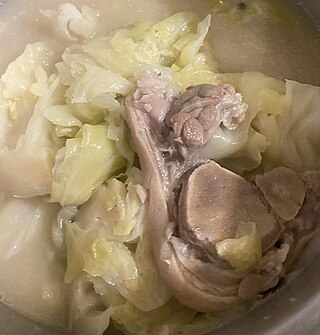
Pares, also known as beef pares, is a term for a serving of Filipino braised beef stew with garlic fried rice, and a bowl of clear soup. It is a popular meal particularly associated with specialty roadside diner-style establishments known as paresan. In recent years, it had also become a common dish served in small eateries called carinderias that serve economical meals for locals.

Misua, also known as wheat vermicelli, is a very thin variety of salted noodles made from wheat flour. It originated in Fujian, China. The noodles differ from mifen and cellophane noodles in that those varieties are made from rice and mung beans, respectively.

Filipino cuisine is composed of the cuisines of more than a hundred distinct ethnolinguistic groups found throughout the Philippine archipelago. A majority of mainstream Filipino dishes that compose Filipino cuisine are from the food traditions of various ethnolinguistic groups and tribes of the archipelago, including the Ilocano, Pangasinan, Kapampangan, Tagalog, Bicolano, Visayan, Chavacano, and Maranao ethnolinguistic groups. The dishes associated with these groups evolved over the centuries from a largely indigenous base shared with maritime Southeast Asia with varied influences from Chinese, Spanish, and American cuisines, in line with the major waves of influence that had enriched the cultures of the archipelago, and adapted using indigenous ingredients to meet local preferences.

Bistek, also known as bistek tagalog or karne frita, is a Filipino dish consisting of thinly-sliced beefsteak braised in soy sauce, calamansi juice, garlic, ground black pepper, and onions cut into rings. It is a common staple in the Tagalog and Western Visayan regions of the Philippines. It is eaten over white rice.

Sinigang is a Filipino soup or stew characterized by its sour and savory taste. It is most often associated with tamarind, although it can use other sour fruits and leaves as the souring agent such as unripe mangoes or rice vinegar. It is one of the more popular dishes in Filipino cuisine. This soup, like most Filipino dishes, is usually accompanied by rice.

Pancit, also spelled pansít, is a general term referring to various traditional noodle dishes in Filipino cuisine. There are numerous types of pancit, often named based on the noodles used, method of cooking, place of origin or the ingredients. Most pancit dishes are characteristically served with calamansi, which adds a citrusy flavor profile.

Noodle soup refers to a variety of soups with noodles and other ingredients served in a light broth. Noodle soup is a common dish across East Asia, Southeast Asia and the Himalayan states of South Asia. Various types of noodles are used, such as rice noodles, wheat noodles and egg noodles.

Dinuguan is a Filipino savory stew usually of pork offal and/or meat simmered in a rich, spicy dark gravy of pig blood, garlic, chili, and vinegar.

Batchoy, alternatively spelled batsoy, is a Filipino noodle soup of pork offal, crushed pork cracklings, chicken stock, beef loin, and round noodles. The original and most popular variant, the La Paz Batchoy, traces its roots to the Iloilo City district of La Paz, in the Philippines.

Paksiw is a Filipino style of cooking, whose name means "to cook and simmer in vinegar". Common dishes bearing the term, however, can vary substantially depending on what is being cooked.

Balbacua, also spelled balbakwa or balbakoa, is a Filipino beef stew made from beef, collagen-rich beef parts, and various spices cooked for several hours until very tender. It is typically served with white rice or misua or miki noodles. It originates from the Visayan regions of the Visayas and Mindanao islands.

Pancit Molo or Filipino pork dumpling soup, is a type of soup using wonton wrappers which originated from Molo district in Iloilo City, Philippines. It consists of a mixture of ground pork wrapped in molo or wonton wrapper, shredded chicken meat, and also shrimp. The piping-hot soup is often ladled into serving bowls, and garnished with green onions and fried garlic bits for another layer of flavor. Pancit, which loosely translates to "noodle" is a common cuisine in the Philippines. The "noodle" acting in this dish comes from the wonton wrappers added to this dish, which draws from Chinese cuisine. Under this influence, the wontons within the soup have been compared to "siomai dumplings."

Kamayan is a Filipino cultural term for the various occasions or contexts in which pagkakamay is practiced, including as part of communal feasting. Such feasts traditionally served the food on large leaves such as banana or breadfruit spread on a table, with the diners eating from their own plates. The practice is also known as kinamot or kinamut in Visayan languages.

Filipino American cuisine has been present in America ever since Filipinos moved there, but only recently has the Filipino food become more widely popular. Filipino food has gone through its evolution of adapting other cultures' food practices into their own, or borrowing the food concept into their own.

The following is a timeline of protests against Rodrigo Duterte, the 16th President of the Philippines, and his policies. Issues were addressed in the protests including the war on drugs, employment issues, anti-terror law, and the government's response to the COVID-19 pandemic.

Pata tim, also spelled patatim, is a Filipino braised pork hock dish slow-cooked until very tender in soy sauce, black peppercorns, garlic, bay leaves, and star anise sweetened with muscovado sugar. It also commonly includes péchay and mushrooms. The dish is commonly served in regions in the Philippines with large Chinese Filipino populations, especially in the Binondo district of Manila.
Pancit buko, is a Filipino dish made from very thin strips of young coconut (buko) meat with various spices, vegetables, and meat or seafood. It is a type of Filipino noodle dish (pancit), even though it does not usually use actual noodles.

Maki mi, also known as pork maki or maki soup, is a Filipino thick pork tenderloin soup originating from the Chinese-Filipino community of Binondo, Manila. It is made from lean pork tenderized by a meat mallet. It is marinated in soy sauce, garlic, black pepper, rice wine or vinegar, and onions before being covered with egg whites or starch. It is then cooked in boiling beef stock, with beaten eggs dropped and stirred until they form strands. Egg noodles (mami) are also commonly added. The name "maki mi" takes its name from Hokkien Chinese, meaning meat soup noodles.

Kulawo is a Filipino salad made with either minced banana blossoms or grilled eggplants cooked in coconut milk that is distinctively extracted from grated coconut meat toasted on live coals. It is a pre-colonial dish that originates from the provinces of Laguna and Quezon. Kulawo is a type of kilawin and ginataan. It is fully vegan and has a unique smoky taste that has been compared to smoked meat or fish dishes.

Lauya is a Filipino stew. Its name is derived from the Spanish-Filipino term "la olla", likely referring to the native clay pots in which stews were made in. It is now often associated with the Ilocano stew typically made with pork or beef. The term is sometimes used in Ilonggo cuisine.




















